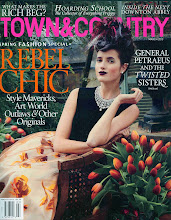
Ashley Hicks has spent years going through journals and archives to create a new book about his late father and style icon. The result, David Hicks: A life of Design by Rizzoli, is compelling and inspired. Ashley, a designer himself, carries on his designer father's legacy with a fantastic fabric collection with Lee Jofa, Stark rugs, and soon to be launched stone flooring with Studium. With 700 images that chronicle the interiors of 1970's design, the pattern and color infused rooms David created serve as a thorough reference of his entire career. Hicks is widely known for his "tablescapes", a way he displayed collections of objects on coffee tables and in vignettes. The mix of bold color, antiques with modern pieces, and tailored upholstery came together in rigorously controlled environments. According to Hick's wife, Lady Pamela, "high-gloss brown walls entered his professional vocabulary after she began throwing glasses of Coca-Cola at him during moments of marital discord." That being said, this legendary whirlwind of emotion and talent is one of the most influential designers of the late twentieth century, who left his indelible mark on the use of color in interiors and how we design today. Collecting his earlier out of print books on ebay at thrift shops and book sales, they fetch high price tags. For the first time, his work is shown in its entirety, making A Life of Design by Rizzoli a library must.
I chatted with Ashley recently by email, where he told me about the experience of putting the book together, and what his father's legacy means to him:
What was it like reflecting on your father's career and looking through the photo archives to put the book together? Are there interiors that still exist in situ?
Lady John Cholmondeley still lives in her fabulous 1967 penthouse, unchanged. It is on pg. 108-9 of the book. Baronscourt, in Northern Ireland, is still exactly the same, and is on pg. 218. Vila Verde in Portugal also, is the same, on pg. 268. My mother lives at The Grove, unchanged except that she has some of my Lee Jofa fabrics now.
It was fun putting the book together. I was very keen to include as much as possible of his best work, and am delighted with the result. I love having the selection of his paintings and graphic designs at the start - they show so much of his stylistic development. I was determined to include a lot of personal things - it was a LIFE of design, and his clothes, his manner, his writing-paper and speedboat flag, all of that was part of his work. I particularly love the JP Stevens promotional film stills on pg.180.
What is your favorite project of his?
His bath/dressing room in Chelsea, 1970, (pg.195) in which I used to sleep when in London, with brown tweed covering floor, walls and furniture, and scarlet-gridded, aluminum tiled panels. It was an incredibly glamorous and exciting space - and I still remember how great the tweed felt to my bare feet.
What about his design and style makes it so relevant today?
He was fantastically creative and always determined that each room - and each house - should be totally different; he also published so much, that it's all recorded. He was also a true artist, with a great feel for colour, pattern and line, and a great knowledge of historical interiors; he had no
fear of his clients - Nicky Haslam, in an obituary, called him an 'Interior Dictator'. All this has left a huge resource for people looking for inspiration today. His design and style would be relevant at any time, I think, because it draws on so many different periods, it mixes so much, that it is utterly timeless. I also notice that a lot of people cite him as an influence while their work is completely different - there is so much in his that everyone can take something...
Is there a favorite story about his work or a project you remember?
For his last great project, Vila Verde in Portugal, he had very indulgent clients/friends who gave him his own room and let him use the house as his own home as much as theirs. So much so that when he was in residence they would retreat to a small, upstairs sitting room which had 2 open, barred 'oculi' looking down on the Great Room where he would entertain his own guests. When I was there the clients both jokingly clung to the bars, wailing 'Let us out! He has imprisoned us up here!'
THE BOOK
 Photos courtesy of David Hicks Archive, from David Hicks by Ashley Hicks, Rizzoli 2009
Photos courtesy of David Hicks Archive, from David Hicks by Ashley Hicks, Rizzoli 2009Never one to shy away from being photographed, Hicks is seen here in a 1961 portrait minding the shop. He is surrounded by white painted antiques poised next to a Georgian chair.
 The drawing room of Peter Coats’s set in A1, Albany, Piccadilly, done in 1961 with an exotic souvenir of Peter’s time in India.
The drawing room of Peter Coats’s set in A1, Albany, Piccadilly, done in 1961 with an exotic souvenir of Peter’s time in India.
The master bedroom at St Leonard’s Terrace, which Hicks decorated in 1963 with his new fabric, Wait a Minim. The the original design stemmed from a collage of tissue paper, known then as and later as Tumbling Rose. It was reissued by Lee Jofa as Ambrosia Rose. This covered walls, including flush cabinets around the bed; roller blinds, bed, and a pair of tablecloths. Bedside tables had cloths of shocking pink felt with glass tops. A dainty Louis XVI canapé was covered in pale pink glazed cotton, with a white glass table, lamps and accessories placed nearby. The matched carpet curtains completed this fresh look. Outside, one of the prettiest views in London, an allee to Wren’s Royal Hospital could be seen.
 Photo (C) Norman McGrath, from David Hicks by Ashley Hicks, Rizzoli 2009
Photo (C) Norman McGrath, from David Hicks by Ashley Hicks, Rizzoli 2009The Alan Vetere apartment in New York, 1971. Hicks emphasised the concrete beams by painting them terracotta, giving the space a real sense of structure, and covering walls and ceiling in his bold, big - scale “Arabic” wallpaper, with a “Celtic” rug on the parquet floor, and an extravagant
fur bedspread. Burnt orange vinyl Roman shades and lacquered table, a chrome étagère and a mirror frame covered in a Hicks hexagon design completed this wild - inspired bedroom.
 Photo (C) John T. Hill, from David Hicks by Ashley Hicks, Rizzoli 2009
Photo (C) John T. Hill, from David Hicks by Ashley Hicks, Rizzoli 2009Mark and Duane Hampton’s first New Yorkliving room in 1968. The walls were covered in grey flannel, the floor in Hicks “Queen Bee” carpet design. Hicks created the interior as a wedding present for the young Hampton, who had briefly worked for him in London before becoming his American associate. Mark, instead, remembered it as a collaboration, although the carpet was a gift. The Roman shade was in washable white vinyl, framed by silvered screens, Louis XVI chairs upholstered in op - art Welsh blankets and a curved canvas by Peter Tangen completed the space.
HICKS DESIGN TODAY:
 Photo Courtesy of Studium
Photo Courtesy of StudiumLaunched this year, the marble and limestone flooring from Studium brings a strong graphic element to a space. Nine designs would look great everywhere from powder rooms to entrance halls.
LEE JOFA GROUNDWORKS FABRICS
 Photos Courtesy of Lee Jofa
Photos Courtesy of Lee JofaThe fabric line debuted a few years back and there is a fabric for every mood, be it graphic, soft prints or small geometrics. The flowers here are a favorite for their watercolor effect print.
Ambrosia Rose Jute Print in Natural/Blue
 Herbert's Carnation Weave in Red/Plum
Herbert's Carnation Weave in Red/Plum La Fiorentina in Wine/Magenta
La Fiorentina in Wine/Magenta Daisy Daisy in Pink/Orange
Daisy Daisy in Pink/Orange
























No comments:
Post a Comment